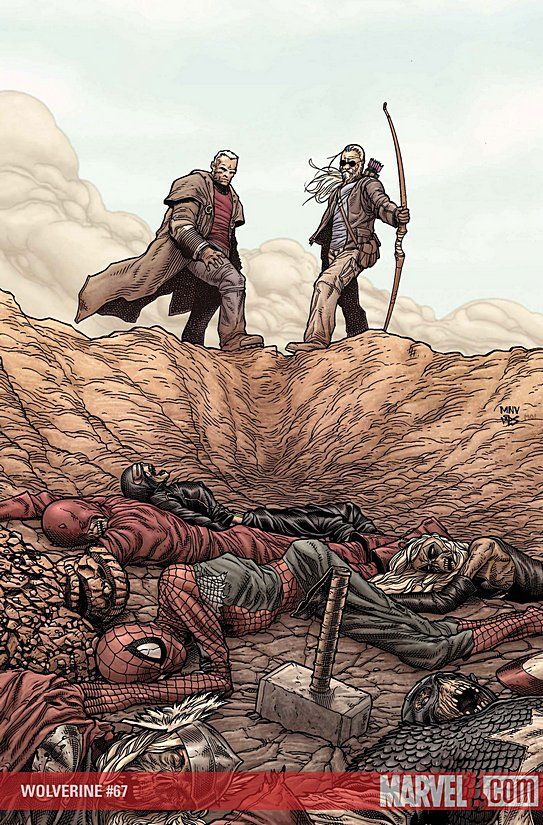"Old Man Logan" Part Two is an improvement over the first part -- at least the silly "Unforgiven" vibe has dissipated -- and this issue shows that the story may turn into something interesting, but in this issue Mark Millar does little more than take us on a sightseeing tour of the post-apocalyptic Marvel America. The reason this comic is still worth reading, though, is the work of Steve McNiven and Dexter Vines.
For simplicity's sake, I'll mostly be talking about McNiven's work here, but Vines is the best inker working today and he deserves mention. Whether he's laying ink over Ed McGuinness's thick line in "Hulk," or adding depth and definition to McNiven's thinner lines here, Vines is amazing. I've seen him work up close at the New York Comic-Con, and the guy can just plain ink. I don't know if fearless is the right word, but he attacks the page with his brush and makes everything look beautiful (or beautifully ugly). So whenever I say anything complimentary about McNiven, keep in mind that Vines is right there beside him.
McNiven's art on "Wolverine" is the best I've seen from him. His use of crosshatching provides a dimensionality missing from some of his other work, and the big open spaces of the arid landscape allows him room for the kind of storytelling we haven't seen much from him. On books like "Civil War" or even "The Amazing Spider-Man," his panels were jammed with characters and background details. It was often overwhelming and even when his individual panels were wonderfully drawn, the entire effect was one of excess. "Wolverine" #67 gives McNiven an opportunity to go from a wide shot to a close up and give the reader a sense of the isolation of these characters -- of Hawkeye and Logan -- as they traverse the desert in the Spidey-Mobile.
Of course, the whole thing is ridiculous. None of it makes any kind of logical sense in the context of what we know about these characters, but that's probably what Millar's banking on. He shows us an utterly broken Wolverine, and we can't help but wonder what could have happened to him that made him turn out like this. And when will the real Logan rise again? And why would even a broken, pacifist Logan let a blind guy drive the Spidey-Mobile? Millar may yet answer some of these questions, but I'm not sure that's where the story's headed. It seems to want to establish that this is a bleak future and these characters are nearly hopeless just so the odds are so much against them that when they do start to fight back, it will be all the more thrilling. The problem is that the lows are unconvincing, so the highs will feel a bit cheap, won't they?
Still, there are some nice moments here, as we see the pilgrims of Hammer Falls and the object of their worship. We see the cult of the superhero from a different perspective, as the people pray for a savior to return. We also see a new hero on the final page -- the first time we've seen a costumed superhero in this bleak vision of the future -- and the identity of this character provides an interesting subtext for the entire story.
"Wolverine" #67 may have its story flaws and gaps in logic, but it is worth checking out. Even if the story is too much of an artificial contrivance, McNiven and Vines are producing one of the best-looking mainstream comics today. That, alone, would get me to buy it.

